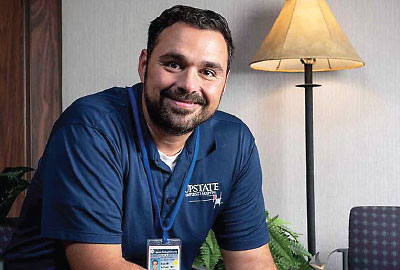Bridge Clinic Cuts Emergency Department Use in Patients With OUD
Abstract
Patients who begin buprenorphine treatment in the emergency department often have to wait for weeks for appointments for follow-up care in their communities. A hospital clinic in Syracuse, N.Y., bridged that gap in care and has seen repeat ED visits drop.
One of the greatest challenges of treating patients who come to the emergency department (ED) with opioid use disorder (OUD) is ensuring that they receive follow-up care and treatment. Although it is becoming more common to initiate treatment with buprenorphine in the ED, there remains a dearth of health professionals who have the necessary waivers to provide the medication in community settings. Local treatment centers and professionals in addiction medicine may be booked solid for weeks, and in the interim patients are left to fend for themselves, at high risk of relapse and overdose. Many end up back in the ED.
The Bridge Clinic at Upstate Medical University Hospital in Syracuse, N.Y., seeks to fill this gap in care. Patients who come to the hospital’s ED are given an initial dose of buprenorphine to manage their withdrawal and are then referred to the clinic, where they continue to receive treatment. In general, patients complete an initial consultation appointment at the Bridge Clinic one to three days after referral. The clinic generally provides outpatient care for patients for up to 12 weeks, but some patients continue to receive care there for longer than that, such as patients who face transportation issues in getting to appointments farther away.

Getting buy-in from health professionals and hospital administrations to create and operate a buprenorphine clinic takes persistence, but it is well worth the effort, says Ross W. Sullivan, M.D.
“Some go to primary care physicians or psychiatrists who provide medication treatment, some go to local treatment centers or outpatient centers that have robust counseling and therapy services, and some we hold on to,” said Ross W. Sullivan, M.D., an assistant professor of emergency medicine and the director of medical toxicology at Upstate.
Sullivan, who is both a toxicologist and an emergency physician, opened the Bridge Clinic in 2017 after noticing a pattern of repeat visits among patients he saw in the ED. Before that, he had been trying to help patients on his own, squeezing them in between appointments with other patients on his toxicology days. The chair of the emergency department heard what he was doing and asked him about it, which led to a conversation about what Sullivan might need to start a buprenorphine clinic in the hospital.
“The first challenge was that there was nothing like it in New York state at the time, so I had to get buy-in from my partners in the emergency department, the department chair, and others in the hospital,” Sullivan said. “That meant educating people on how to give [buprenorphine] and convincing them there was a need for them to do it. It also meant convincing people we needed space for the clinic. It felt like I went to a thousand meetings the year before [the clinic opened].”
The Bridge Clinic offers comprehensive treatment for OUD. Patients see not only health care professionals but a peer advocate certified by New York state or a member from their community who has OUD and can offer support from the vantage point of shared experience.
“Peer advocates help patients get connected to community treatment and help them with things like signing up for Medicaid or disability. They’re familiar with the process because they’ve done it themselves,” Sullivan explained. “But they also offer [more personal] counseling and advice because they have been through what the patients are going through with substance use.”
Referring patients to the Bridge Clinic from the ED has cut the number of future ED visits among patients with OUD and helped patients stay in treatment. In a study in the Journal of Substance Abuse Treatment, Sullivan and colleagues analyzed data from 269 patients who were seen in the Bridge Clinic for the first time in 2017 or 2018. This population accounted for a total of 654 ED visits in the six months before their first clinic visit and 381 visits in the six months after their first clinic visit. Most of these patients—92%—attended three or more Bridge Clinic appointments, and 56% were still taking buprenorphine two years later.
“I was very pleasantly surprised at the results,” Sullivan told Psychiatric News. “I’ve spent so much time working with these patients as part of being an emergency medicine physician, and it’s good to show that this works.”
Although Sullivan and his team have not yet studied the financial impact of the Bridge Clinic, he believes it is a positive one.
“You can imagine the savings of reducing emergency department visits. That in and of itself should have hospitals thinking of having clinics like this,” he said.
Sullivan encourages psychiatrists to look for gaps in care and find other health professionals who can help develop and implement solutions.
“In my journey, I found many people along the way who believed in the mission, but you have to be persistent,” he said. “There is merit to these types of programs because patients will use them. Build it and they will come.”
Sullivan and colleagues did not report any outside funding for their research. ■
“Bridge Clinic Buprenorphine Program Decreases Emergency Department Visits” is posted here.



